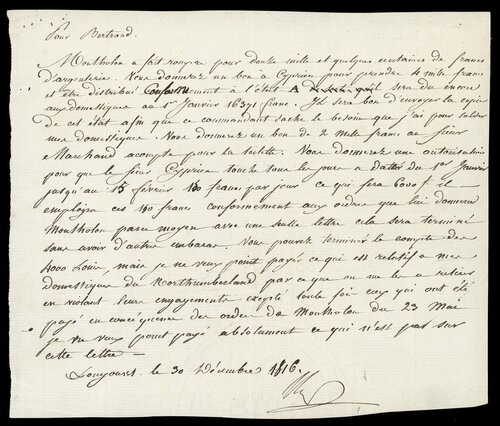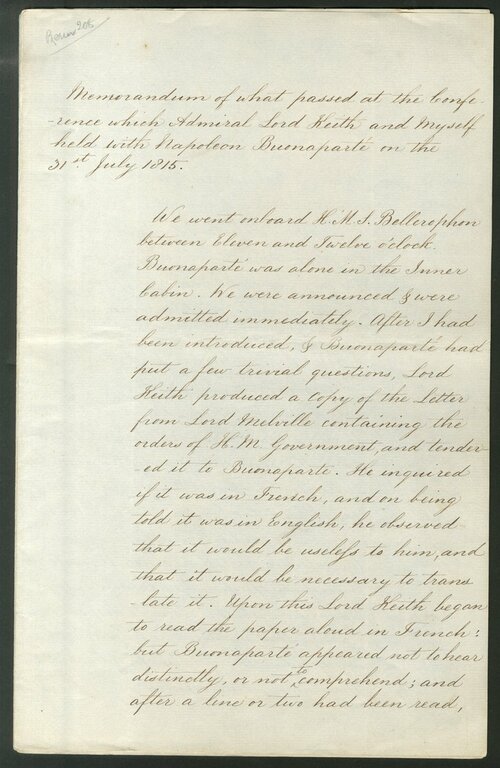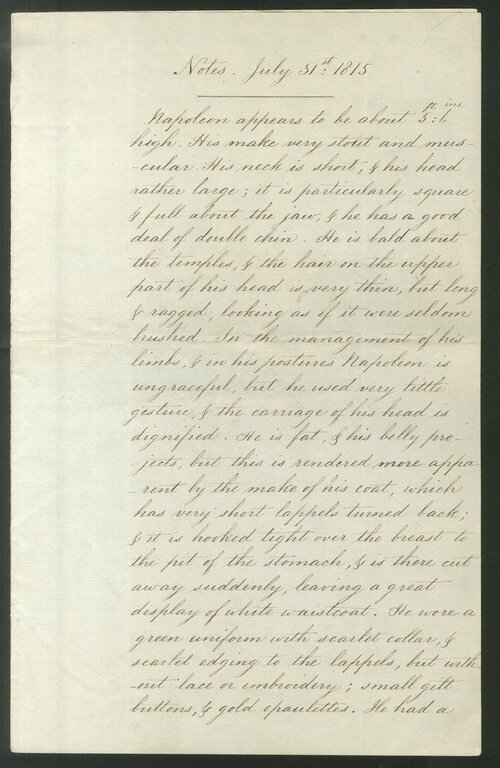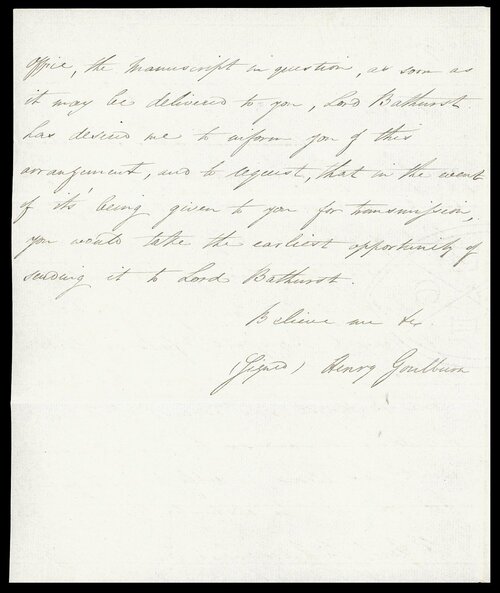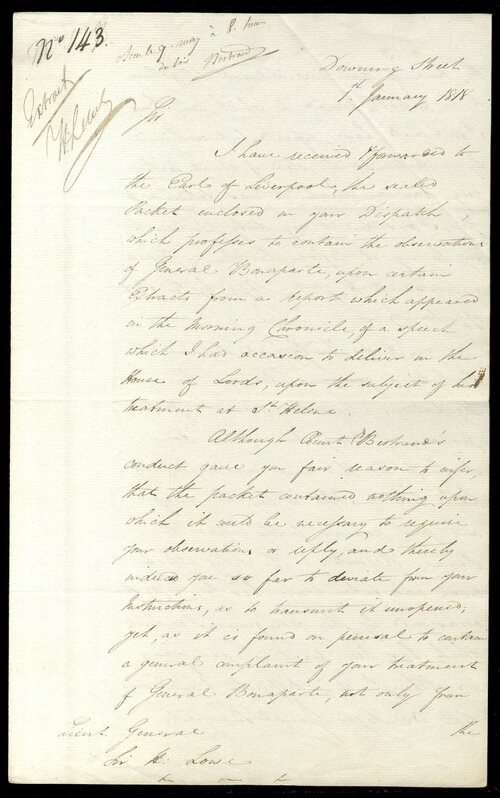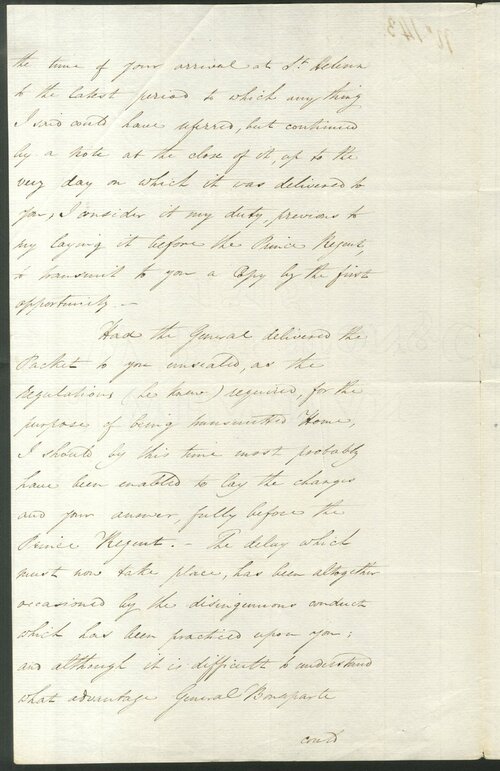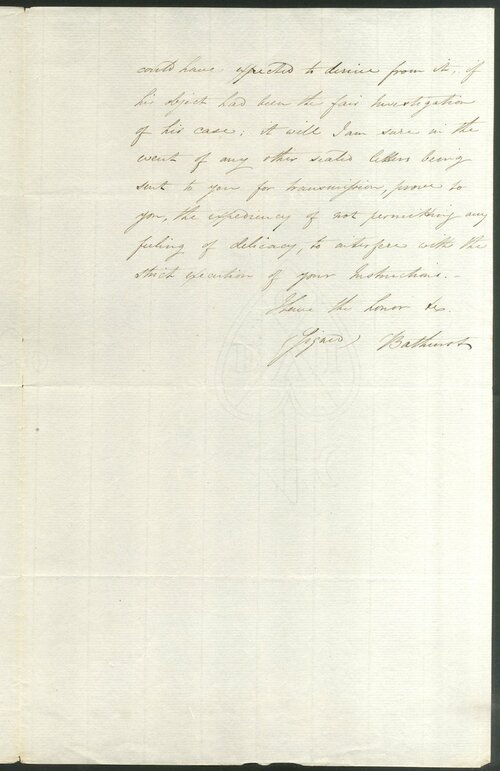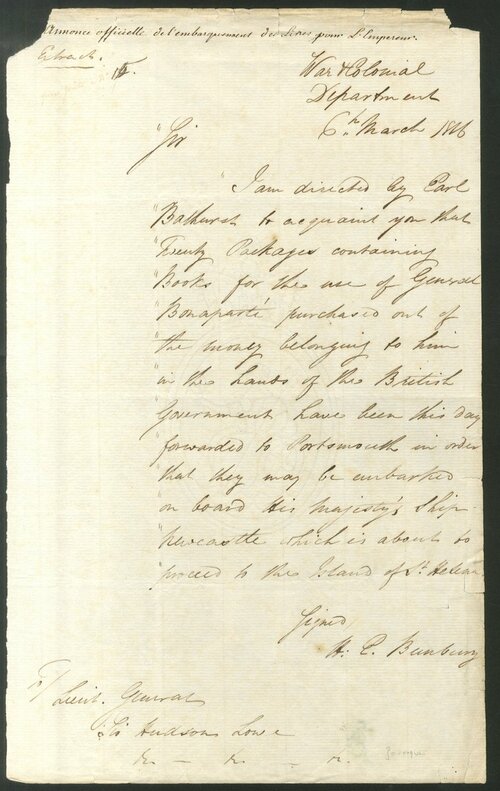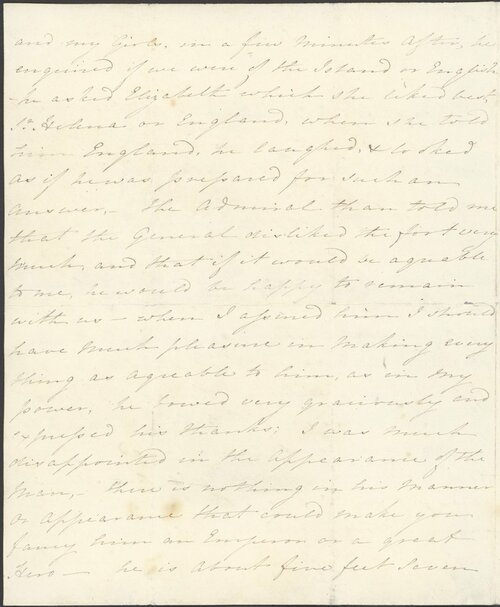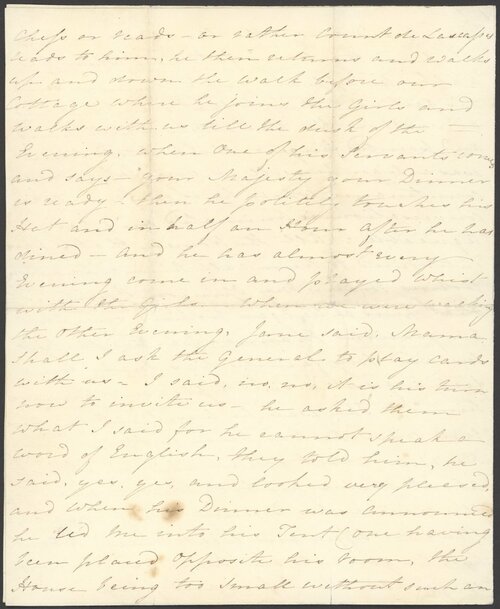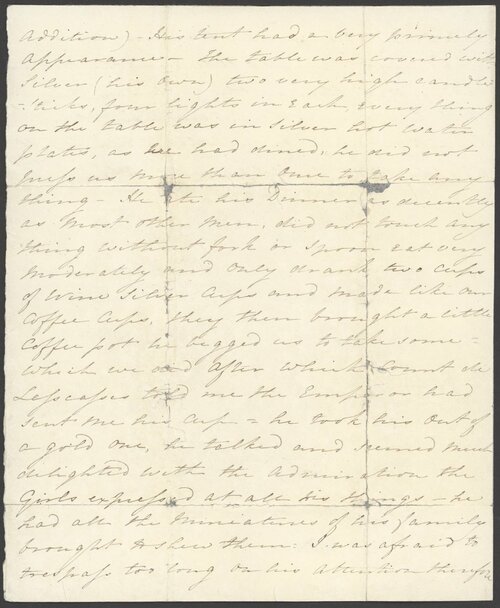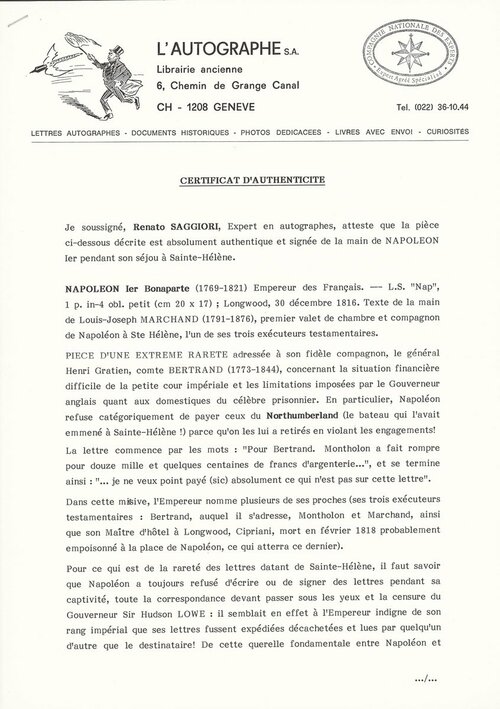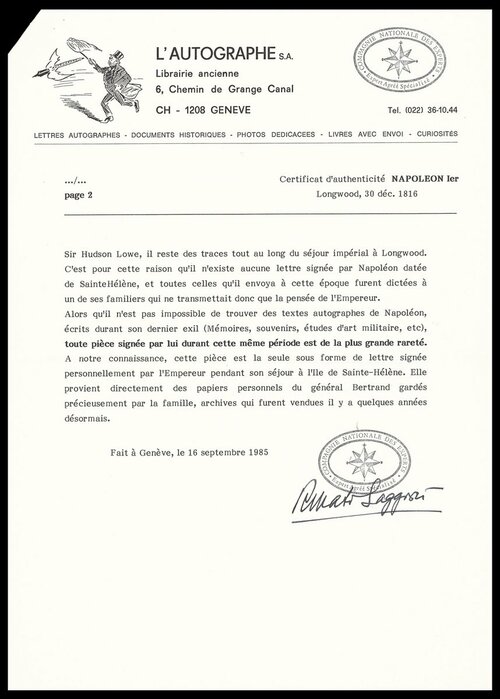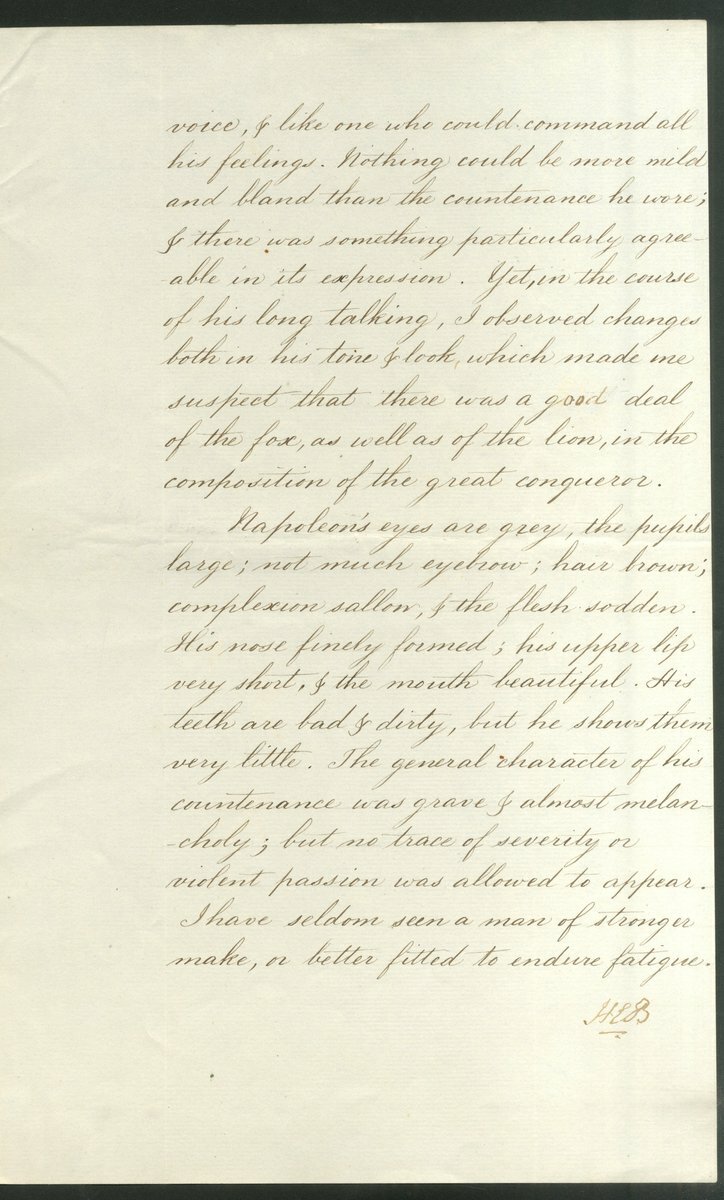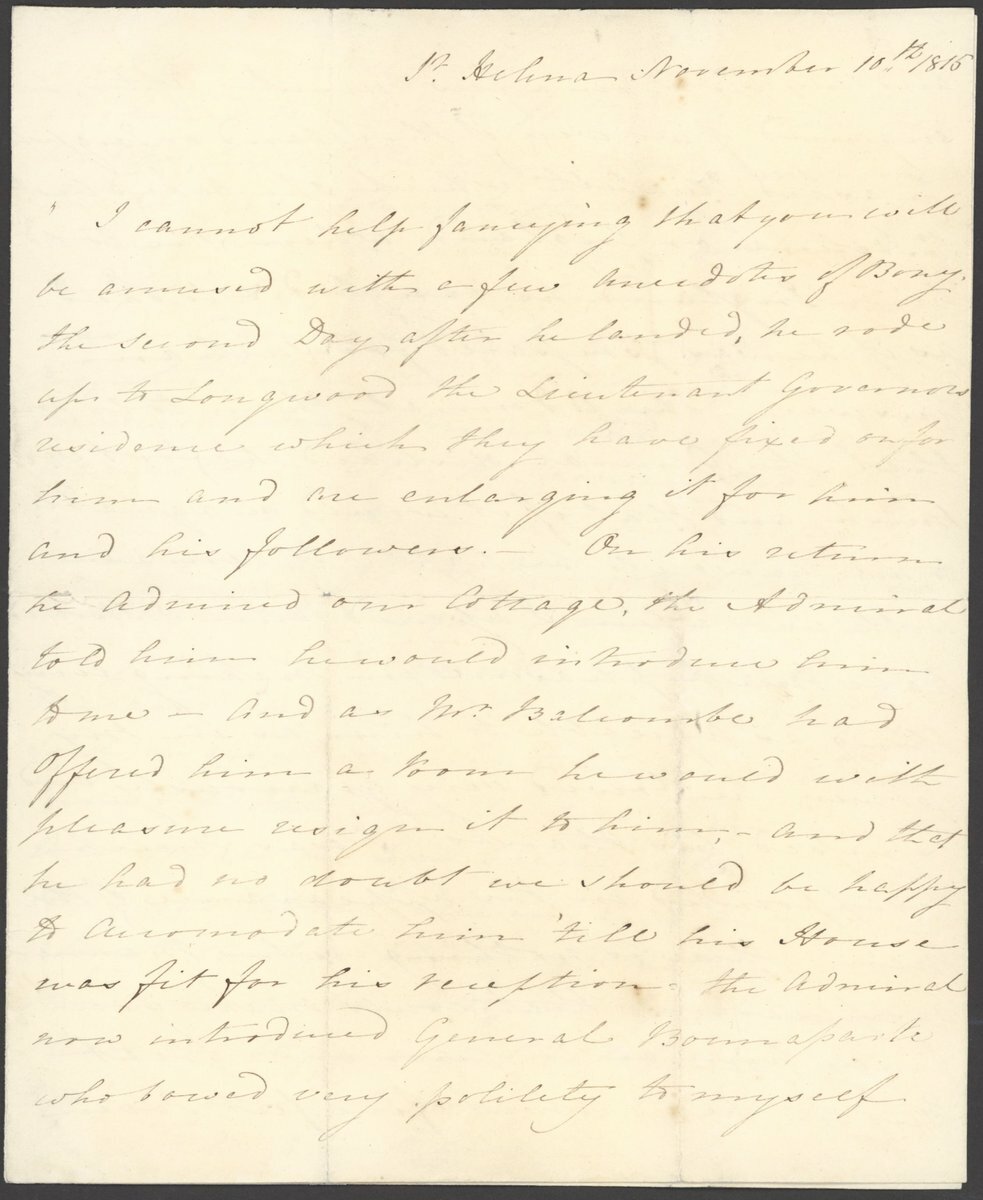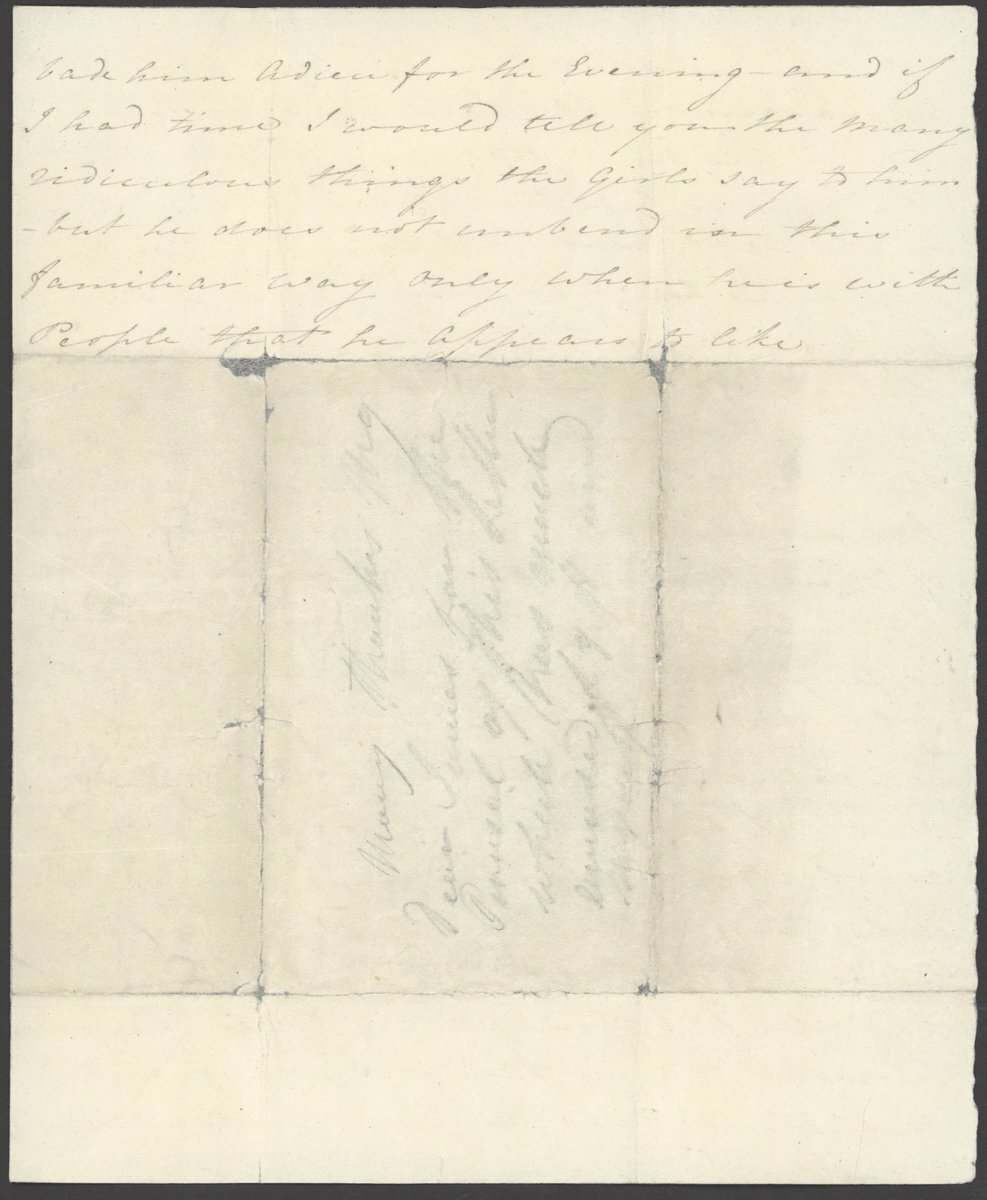Auction: 21066 - Historical Documents, Postal History and Autographs
Lot: 241
Napoleonic Wars
St. Helena
Napoleon Bonaparte's Exile in St. Helena, 1815-41
An unparalleled archive of Napoleon Bonaparte's exile on St. Helena comprising multiple documents of varying types that provide a unique insight into life for Napoleon, his French entourage, his British captors and those native to the island. This must be seen as a complete collection of an intriguing and famed period in British and French history.
The collection commences with Napoleon's surrender to the British and a lengthy, detailed memorandum by Sir Henry Bunbury of the discussions between Lord Keith, himself and Napoleon Bonaparte on 31st July 1815 on board H.M.S. Bellerophon. After the reading of Lord Melville's letter containing the orders of the British government, there is a virtual verbatim report of Napoleon's response and protestations which includes, "...In St. Helena I should not live 3 months - With my habits and constitution it would be immediate death. I am used to ride 20 leagues a day; what am I to do on this little rock at the end of the world. The climate is too hot for me. No, I will not go to St. Helena. Botany Bay is better than St. Helena...". After this comprehensive account there is also a double page of notes, describing Napoleon's appearance and dress, and with reference to his character, "... in the course of his long talking, I observed changes both in his tone & look, which made me suspect that there was a good deal of the fox, as well as the lion, in the composition of the great conqueror." A wonderful report of which very few copies would have been written.
On Napoleon's arrival on St. Helena, he was put up at The Briars, the house of William Balcombe, purveyor to Longwood. There is a long letter from Mrs. Balcombe dated 1815 (10 Nov.) which contains good insight into the mood of Napoleon on his arrival, "...I was much disappointed in the appearance of the man, there is nothing in his manner or appearance that would make you fancy him as an Emperor or a great hero - he is about five feet seven, very broad across the shoulders and is inclined to get very fat and when he walks he appears quite clumsy and his gait is betwixt that of a strut and a waddle ... My opinion of him is that he is a vulgar looking one, but his gracious manners, particularly to me and my family has made me feel a great desire to please and amuse him." Though there initial meetings were tentative, Mrs. Balcombe, her family and Napoleon would grow close, Mrs. Balcombe being afforded the liberty of referring to Napoleon as "Boney" without reprimand.
The key item is the only known extant letter signed by Napoleon during his final exile - 1816 (30 Dec.) mail from Longwood written in French by Las Cases and signed by Napoleon. "For Bertrand, Montholon has had some silverware melted down for twelve thousand and some hundred francs. You are to give and order to Cyprien to take four thousand francs to be distributed according to state A. On January 1st the servants will still be owed 16,371 francs. It would be good to send a copy of this account so that this Commander knows that I have to pay my servants. You are to give an order of 2,000 francs to Mr. Marchand as payment for his clothing. You are to give authorization that Mr. Cyprien receives 150 francs daily from January 1st to February 15th which will be 6,000 francs. He is to use these 150 francs in accordance which Montholon will give to him. In this way, with one letter this will be concluded without any further difficulty. You can settle the remaining account of 4,000 Louis, but I do not want to pay for anything concerning my servants of Northumberland because they have been dismissed in violation of their commitments, excepting always, those who had been paid because of the orders of Montholon on May 23rd. I absolutely do not want to pay for what is not in this letter. Nap".
Offered with Compagnie Nationale Des Experts Certificate of Authenticity (1985) stating that this is the only such example known to committee to date.
It is well known that Napoleon grew disillusioned with writing from St. Helena owing to British censorship. Las Cases, in a letter to Lucien Bonaparte (September 1816), noted that Napoleon was upset that others read his personal correspondence: "He would rather receive no more letters than receive them on these terms". British censorship dictated that Napoleon's letters must be sent unsealed, "In these circumstances the Emperor deems it advisable to renounce letter writing".
The context for Napoleon's letter here is that when the British Government had reduced its expenditure on Longwood in July of 1816, Napoleon had offered to cover expenses if he were permitted to send letters unsealed to his bankers. This deal was refused and Napoleon arranged for much of his silverplate to be sold off in public protest, arousing much sympathy for Napoleon. Our letter details the distribution of funds from this sale.
Inevitably Napoleon and his entourage found ways to avoid censorship; one such method was to write smuggled messages in a miniscule hand on small pieces of paper. The only known extant example of a smuggled document comes from Bertrand's archives, written by Napoleon's second valet, Etienne St. Denis 1819 (16 Aug.) on paper measuring 20.3x5.5cm, folded seven times vertically so the message would have been approx. 2.5x5.5cm when folded. The letter contains Napoleon's "Declaration" which was published by Antommarchi in his Memoirs.
A cypher overlay devised by Bertrand represents another method used to avoid censorship. The cypher could be used for four different codes, the sheet being numbered "1, 2, 3 and 4" along the top". The document is also endorsed "Found among the papers of Napoleon".
Housed in a binder is a series of nine letters between 1816-17 from General Sir Hudson Lowe to Bertrand, most with Bertrand's filing numbers in upper left corner, with six documents signed or initialled by Hudson Lowe plus copies and/or translations of letters written by Les Cases (5). Topics discussed are mostly reminders of regulations on the island though some provide reports on potential delay in receiving letters and make suggestions on the correct methods of sending and receiving letters on St. Helena. A further two ALS in 1819, one to Dr. Verling hand delivered on St. Helena with reference to books for Madame Bertrand, the other to Sir Thomas Reade. Also fourteen letters from Les Cases.
1816-18, a series of Governments letters including a letter from the War and Colonial Department, dictated by Earl Bathurst to the Governor with regard to twenty packets of books being despatched and with the accompanying letter (numbered 15) from Hudson Lowe, addressed to Count Bertrand. 1818 (1 Jan.) letter from Earl Bathurst to Hudson Lowe about acts of trickery by Count Bertrand, forwarded on with "Extract, H Lowe" also with Bertrand's signature and (numbered 143); 1818 (14 Feb.) letter from Downing Street to Hudson Lowe raising no objection to Count Las Cases helping the publication of Napoleon's book, "Campaigns of Italy", again with the covering letter from Plantation House (numbered 155).
Other mail into Longwood includes a significant series of letters from Count Las Cases to Count Bertrand, January 1818 to April 1819 (numbered by Bertrand, 1, 2, 3, 4 then apparently 5-15). Las Cases was deported from St. Helena by Hudson Lowe and travelled through Germany and Belgium before being allowed to return to France. These letters are sent from Frankfurt, Baden-Baden, Mannheim and Offenbach, nine are with address panels, the earlier ones to Monsieur General Comte Bertrand, St Helena, one to Longwood, St. Helene and finally just to Longwood, one letter damaged on opening with the notation, "This letter was accidentally torn at the office on opening the envelope, Colonial officer Henry Gouldburn, Feby 25th 1819" (this shows that there was censorship in London). Some of the earlier letters have minor faults.
Other related items include 1818 letter from Hudson Lowe to Sir Thomas Reade. 1816 (31 Dec.) Dunlop entire to Ayr bearing a fine example of the rare "
A most valuable correspondence, 1815-16, to Amy Whinyates, Cheltenham from her sister, Mrs Younghusband, which includes a hitherto unrecorded "
1821 (8 May) memorandum from Robert Lambert, Rear Admiral and Commander in Chief about the order for the funeral of Napoleon including, "His Majesty's ship Vigo with fire twenty five Minute Guns, commencing when the Signal for that purpose is made from the Alarm Post."
The final section is a group of letters written to General Bertrand on his return to St. Helena in 1840-41 to repatriate Napoleon's body to France, each with Bertrand's notation at top, two with address panels (one an envelope) to "La Belle Poule" with letter from Henri Durand-Brager (artist), plus six others. Also two other St. Helena documents, not related to Napoleon.
A unique opportunity for the discerning collector of the Napoleonic Wars, Napoleon or St. Helena to acquire a remarkable bank of material with relevance to both British and French parties.
Sir Henry Bunbury served as Under-Secretary of State for War and the Colonies from 1809-16. He was promoted to the rank of Major-General and awarded the KCB in 1815, shortly before his meeting with Napoleon.
The British authorities finally came to the decision about what to do with Napoleon on 31 July and it was Lord Keith's duty to inform Napoleon that he was to be exiled on the island of St. Helena. He would be allowed to take three officers, his surgeon and twelve servants. The three officers were the Comte de Las Cases, General Henri Bertrand and General Charles Montholon.
General Henri Gratien Bertrand had served at Waterloo as Napoleon's aide and he chose to accompany Napoleon into exile, along with his wife and family.
Emmanuel de Las Cases, nearly 50 years old upon his arrival at St. Helena as Napoleon's secretary. Las Cases, a former naval officer and a count, spoke English -- an important asset to Bonaparte and successfully taught him English. Later Napoleon would read the English newspapers to keep abreast of the news.
The duties of running the imperial household fell to General Charles Tristan Montholon, 32 years old. The Montholon family occupied three rooms at Longwood.
Hudson Lowe was the son of an Army surgeon and not part of the British aristocracy. Lowe was born in 1769 two weeks before Napoleon making them exactly the same age. Up until the time Lowe assumed the care and custody of Napoleon at St. Helena in April, 1816, he rose through the ranks based upon his merit.
Credit must go to Arthur H. Groten, M.D. who provides a wealth of research and context to the material presented here in his "The Postal History of St. Helena During the Napoleonic Exile", October 1991
Subject to 20% VAT on Buyer’s Premium. For more information please view Terms and Conditions for Buyers.
Sold for
£85,000
Starting price
£55000

